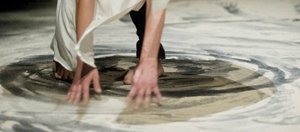Ildikó Takács considers how the universal language of dance can encourage cross-cultural collaboration and work

When looking for the official language of Europe, why not choose dance? In the run-up to the DancEUnion Festival at the Southbank Centre this month, where dancers from Austria, Belgium, Bulgaria, Cyprus, the Czech Republic, Denmark, Estonia, Finland, France, Germany, Hungary, Ireland, Italy, Latvia, Lithuania, the Netherlands, Poland, Romania, Spain and the UK will appear before London audiences, I have been thinking about the communication that dance makes possible.
The festival is preceded by three days of workshops, providing an opportunity for the dancers to work and think together using the international language of dance and, it is hoped, to forge personal-professional links and prepare the ground for possible artistic collaborations in the future. Stimulating artistic mobility is an essential concept of DancEUnion as it provides a way to share knowledge and build bridges between different cultures and attitudes. Knowing each other is important for co-operation and speaking a common artistic language is a good start. Constructing a shared European cultural identity which is built upon the diversity of its artistic expression is another important aspect of our work. Promoting such an intercultural dialogue is a way to promote European cultural identity.
The European Union National Institutes for Culture (EUNIC) aims to enhance intercultural dialogue through education, language, youth science and, of course, the arts. Its London cluster initiated DancEUnion for the European Year of Intercultural Dialogue in 2008. EUNIC London, part of the global network, was established in 2007 as an association of 11 cultural institutes of EU member-states represented in London. It aims to be informal, bureaucracy-light and committed to joint working on creative projects which show Europe’s richness and diversity in arts, culture and language. Its main focuses are intercultural dialogue and multilingualism, and it now has 23 members and associate-members who share knowledge and resources on a common European agenda. Its Charter spells out its mission, and aims to position EUNIC London as a flexible association open to working collaboratively with British and international organisations.
EUNIC works closely with the European Commission Representation in the UK, and with several European embassies, to build strong cultural relationships between EU countries. The wordless dialogue made possible through dance is a highly efficient way of creating a link between dancer and audience, culture and culture, human and human. The different attitudes of the festival dancers to politics, body, happiness and other important issues will not only teach us about another culture but will make us reflect upon our own.
As in Europe itself, DancEUnion shows – through the performances – confrontations and mixtures of the European dance scene. The dance practices come from all over Europe, offering an opportunity to raise awareness and to show, despite the financial and economic crisis, that art and culture are still a very important cornerstone of European identity, shared values and norms.
According to the old saying, it takes two to tango. By extension, it takes several tangueros to have a ‘milonga’ – a ball. Likewise, the national cultural institutions can have their solo dances but to have a large-scale, huge-impact ‘ball’, they have to collaborate. DancEUnion aims to be this collaborative project with a collaborative aim. In the spirit of ‘unity is strength’, the cluster of national cultural institutions in London is able to exercise a larger impact and influence when working collaboratively. In a multicultural and competitive city like London, collaboration is essential: it endows the work with more importance, a higher impact and lower costs. With joint forces, EUNIC can work for cultural diplomacy and soft power as well as a partner to such established and highly regarded cultural institutions as the Southbank Centre.
Collaborating within EUNIC on a project such as DancEUnion is a complex process, which requires great attention to collective and individual expectations and positions. All the partners are going through a learning process, overcoming cultural and language differences to achieve a common objective. By supporting events and artistic activities EUNIC can create a link between cultures and encourage cultural exchanges. EUNIC’s answer for these emerging issues is dance: a dialogue between bodies which transcends words and borders – like Europe.
Dr Ildikó Takács is President of EUNIC and Director of the Hungarian Cultural Centre.
http://www.eunic-london.org



